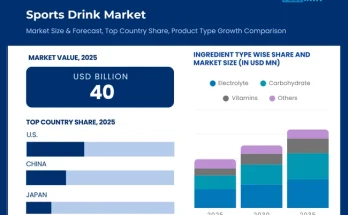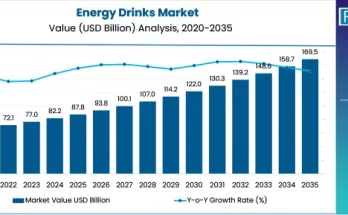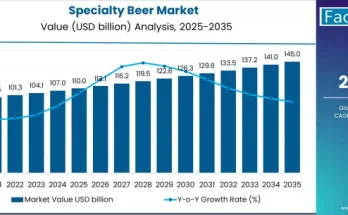In 2025, the Plant Protein Ingredients Market is projected to be valued at approximately USD 20.3 billion, with estimates predicting a rise to about USD 46.0 billion by 2035, reflecting a compound annual growth rate (CAGR) of 8.5%. This growth represents more than double expansion over a decade, driven by both volume increases and rising prices for higher quality, specialty protein products.
By source, pea protein is expected to lead with around 40% share of the market in 2025. By application, food & beverage uses dominate, accounting for roughly 60% of demand, followed by sports nutrition, dietary supplements, animal feed, infant and clinical nutrition. In terms of product types, protein concentrates remain most widely used (due to their cost / protein content balance), with isolates and textured proteins following upward in demand, especially for premium and high-performing applications.
Drivers & Trends Shaping Growth
Several strong macro-trends are pushing this market forward:
-
Rising consumer demand for plant-based diets, flexitarian lifestyles, and environmental sustainability. Many consumers now view plant proteins as healthier, more ethical, and more sustainable than animal sources.
-
Increased innovation in food formulation and the ongoing search for meat substitutes, dairy alternatives, protein-fortified foods, and novel delivery forms. Texture, taste, and clean label claims are shaping which ingredients succeed.
-
Regulatory and health-driven factors: concerns over lactose intolerance, allergenicity, animal welfare, climate change, and food security are pushing both consumers and regulators toward greater adoption of plant-based proteins.
-
Technological improvements in extraction, purification, flavor masking, and functionality enhancement (solubility, emulsification, binding). These enable ingredients to perform better in end-products and help bridge the sensory gap with animal proteins.
Recent Developments & Innovation Highlights
To understand where the market is moving, here are recent developments:
-
A leading ingredient provider launched a fava bean protein isolate with ~90% protein content designed for use in meat alternatives, non-dairy substitutes, baked goods; notable for having cleaner taste and lighter color, making it easier for manufacturers to integrate without strong flavor interference.
-
Expansion of plant protein lines into new geographies: firms that had been focused on North America and Europe are broadening distribution into markets like India, Middle East, Turkey, and parts of Asia Pacific to capture growing demand.
-
Establishment of innovation centers by leading players to improve R&D capabilities—improving extraction efficiency, functionality, flavor, and processing throughput. These centers are helping bridge the gap between lab formulations and commercial scalability.
-
Start-ups entering with novel sources (e.g. fava, novel legumes) or improved processing technologies that reduce off-flavors, improve solubility, and enable better nutritional profiles.
Key Players & Competitive Landscape
Several well-established companies lead in plant protein ingredient production. They are investing heavily in processing capacity expansions, R&D, sustainability, and quality. Some of the prominent names include:
-
Ingredion Incorporated, known for functional proteins and varied source portfolios.
-
Cargill, with strong agricultural and supply chain integration.
-
DuPont, addressing nutritional optimization and specialty functionality.
-
Roquette, active in fava and pea protein developments.
-
ADM, Kerry Group, Puris Proteins, Burcon NutraScience, The Scoular Company, Axiom Foods are also key players, each differentiating on source, purity, functionality, or sustainability credentials.
These players compete on several fronts: protein source (pea, soy, others), form (concentrate vs isolate vs textured), functional and sensory quality, cost, and claims around sustainability (non-GMO, organic, environmental impact, traceability).
Regional Insights: United States & Europe
United States
The U.S. market shows one of the strongest growth trajectories, with projected CAGR around 9.2% through 2035. Drivers include a robust consumer base receptive to plant-based innovations, strong food & beverage R&D infrastructure, rising investment in alternative protein products, and regulatory encouragement for sustainable labeling. Manufacturers are focusing heavily on texture, clean flavor, and scaling up production.
Europe
Europe is also showing strong growth (CAGR in the region of ~8.5-9%), driven by consumer demand for sustainability, stricter regulation around food additives, clean labeling, and environmental impact. Countries such as Germany, France, UK, Netherlands, and the Nordics are at the forefront. In addition, European companies often lead in processes that ensure low environmental footprint, transparency in supply chains, and claims such as non-GMO, organic, and regenerative agriculture sourcing.
Challenges & Market Restraints
Even with strong growth, the market faces serious obstacles:
-
Cost pressures: Higher price of raw materials (pulses, novel legumes), extraction, refining, and flavor masking components make premium proteins more expensive than commodity animal proteins in many markets.
-
Sensory issues: Taste, texture, color, and solubility often lag behind animal protein, especially in highly processed or neutral flavor applications. Overcoming off-flavors and achieving desired mouthfeel remain key R&D challenges.
-
Raw material supply volatility: Weather, crop yields, agricultural practices, and geopolitical issues affect supply stability and cost.
-
Regulatory, labeling, and consumer education: Fraudulent claims, misunderstanding about “complete protein,” allergen risks (e.g. soy), and diverging regulatory standards across regions can slow adoption or lead to consumer distrust.
-
Competition from emerging alternative proteins (fermentation, cultured, hybrid proteins) which may offer different value propositions (texture, nutritional completeness, novelty).
Outlook & Strategic Implications
Looking forward, market growth will likely be concentrated in:
-
Novel protein sources (beyond soy and pea) that address allergenicity, flavor, and environmental concerns.
-
High functionality ingredients – isolates, textured forms, and ingredients optimized for specific food & beverage applications (e.g. meat analogs, dairy alternatives, protein beverages).
-
Sustainability credentials – non-GMO, organic, local sourcing, regenerative agriculture, low carbon and water footprints will become more critical differentiators.
-
Geographic expansion – Asia-Pacific, Latin America, and emerging markets are expected to see fastest percentage growth although baseline values are still smaller.
-
Collaborations & partnerships between ingredient companies, food manufacturers, start-ups, breeders (for novel legume crops), and technology firms for extraction & processing innovation.
Browse Full Report: https://www.factmr.com/report/4507/plant-protein-ingredient-market
Editorial Take
From my editorial standpoint, the Plant Protein Ingredients Market is entering a maturation phase: what counts now is not just growth, but quality. The winners will be those who deliver ingredients that don’t force trade-offs: protein quality and taste; functionality and sustainability; cost and premium positioning. The future is not just plant-based—it is plant-optimized.
Ingredient suppliers who invest in R&D, processing technologies, supply chain transparency, and sustainability will not only satisfy consumer demands but earn brand trust. U.S. and European markets will continue to define standards and expectations, while markets in Asia, Latin America, and beyond will follow with strong potential.



